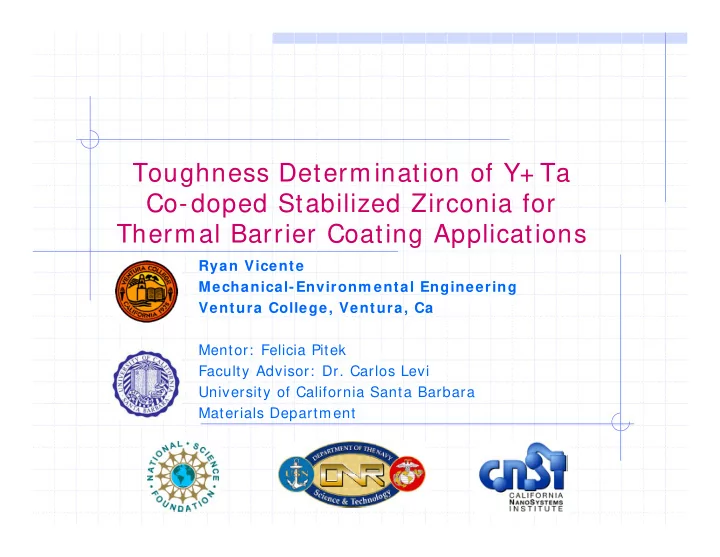

Toughness Determination of Y+ Ta Co-doped Stabilized Zirconia for Thermal Barrier Coating Applications Ryan Vicente Mechanical-Environm ental Engineering Ventura College, Ventura, Ca Mentor: Felicia Pitek Faculty Advisor: Dr. Carlos Levi University of California Santa Barbara Materials Department
Thermal Barrier Coating System Thermal Barrier Coating (TBC) Heat Transfer Ceramic coatings thermally insulate metallic substrate. Thermally Grown Oxide (TGO) Prevents oxidation of the Bond Coat Bond Coat Adherence of TBC to supper alloy Provides Aluminum for TGO Superalloy Material of turbine components State-of-the-Art TBCs Consist of yttria-stabilized-zirconia (7YSZ) applied by electron beam physical vapor deposition or plasma spraying. Turbine Blade Ryan Vicente Courtesy of Levi Group July 29, 2005 Ventura College
Applications of Thermal Barrier Coatings Used in Gas Turbine Engines Insulate metal alloy components from high operating • temperatures of 1100º C. Funding by the Office of Naval Research Develop TBC material with increased resistance to • corrosion by impurities in fuel. Increase the operating temperature at which TBC • materials can operate to increase efficiency. Ryan Vicente July 29, 2005 Ventura College
Purpose of Research Erosion Causes TBCs to lose small to large layers which may expose the • underlying metallic substrate to high engine temperatures. Higher toughness leads to an increased resistance to erosion. • New Y+ Ta co-doped compositions must meet or exceed current • TBC material toughness values. Exposure of turbine blade by erosion. Small particle erosion. Ryan Vicente July 29, 2005 Courtesy of J. Nicholls, Cranfield University Ventura College
Toughness Measure of resistance to crack propagation. Tetragonal bonding of yttria + tantala co-doped system theorized to increase toughness, the resistance to erosion, of TBC materials. Multiple compositions of varying percentages of yttria and tantala must be tested. Results compared to toughness characteristics of the yttria-stabilized-zirconia TBCs in use. Ryan Vicente July 29, 2005 Ventura College
Flow Chart Characterize Precipitate into Pyrolize into precursor solutions oxides at 900°C ammonium hydroxide Sinter pellets at Mount Press powder into pellets. 1500ºC and polish. Vickers Hardness Observe indentation using Calculate toughness Test with Microindenter Scanning Electron Microscopy Ryan Vicente July 29, 2005 Ventura College
Indentation Vickers Hardness Test Microhardness test with a pyramidal diamond indenter. • Indentation forces crack propagation from corners. • Cracks measured and used to calculate toughness. • F 136º Indenter Cracks Indentation Pellet Ryan Vicente July 29, 2005 Ventura College
Measuring Crack length is measured in the SEM. Length crack along with force applied to cause fracture used to calculate toughness. All corners should have uniform crack length. Ideal indentation lacks cracking from sides. (22YO 1.5 + 12TaO 2.5 ) Stabilized ZrO Ryan Vicente July 29, 2005 Ventura College
Measuring F 136º Crack c d c H = 2 d 2 d P ) ( ) ( = ξ 1 / 2 3 / 2 K c E H P c J. Am. Ceram. Soc. Vol.64 No.9,pp533 (1981) (22YO 1.5 + 12TaO 2.5 ) Stabilized ZrO d: the half diagonal length of vickers impression Kc: toughness E: Young's modulus H: Hardness xi: constant (0.016) P: load Ryan Vicente c: crack length from a center of impression to a crack tip July 29, 2005 Ventura College
Problems with Present Materials Sintered pellets not dense enough for indentation. (17YO 1.5 + 17TaO 2.5 ) Stabilized ZrO 2 (22YO 1.5 + 12TaO 2.5 ) Stabilized ZrO 2 Subsurface pores cause collapse. Ryan Vicente July 29, 2005 Ventura College
New Direction Sinter Forge Pressure and high temperatures of around 1300°C. • Forces material to move, thereby filling pores. • Increases density of pellet. • Courtesy of Rafael Leckie, UCSB Hot Press Pellet before Pellet after Ryan Vicente July 29, 2005 Ventura College
Summary Progress Sintered pellets of co-doped TBC material. • Indentation of pellets. • Samples determined too porous for toughness testing. • Continued Research Reduce porosity of pellets. • Employ sinter forging process. • Check constants for accuracy in toughness calculation. • Ryan Vicente July 29, 2005 Ventura College
Acknowledgements Levi Group Office of Naval Research National Science Foundation California NanoSystems Institute Ryan Vicente Ryan Vicente July 29, 2005 LissanRyan@yahoo.com Ventura College
Recommend
More recommend